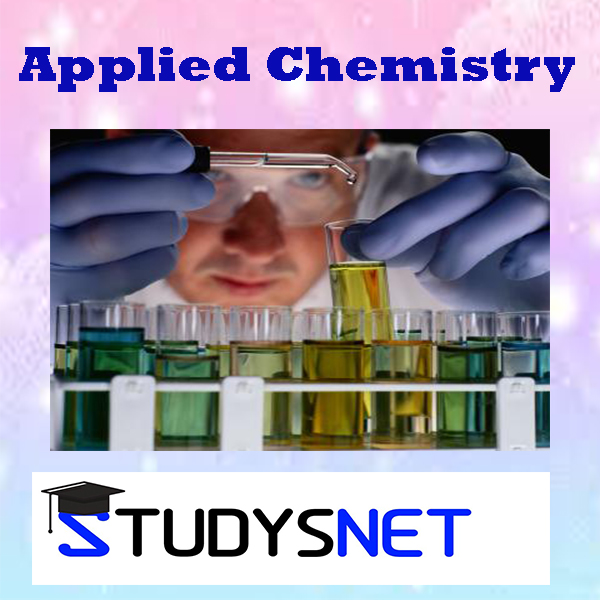Applied Chemistry free videos and free material uploaded by Ramanjaneyulu K .
Knowledge of basic concepts of Chemistry for Engineering students will help them as professional engineers later in design and material selection, as well as utilizing the available resources.
Learning Objectives:
• Plastics are nowadays used in household appliances; also they are used as composites (FRP) in aerospace industries.
• Fuels as a source of energy are a basic need of any industry, particularly industries like thermal power stations, steel industry, fertilizer industry etc., and hence they are introduced.
• The basics for the construction of galvanic cells as well as some of the sensors used in instruments are introduced. Also if corrosion is to be controlled, one has to understand the mechanism of corrosion which itself is explained by electrochemical theory.
• With the increase in demand, a wide variety of materials are coming up; some of them have excellent engineering properties and a few of these materials are introduced.
• Understanding of crystal structures will help to understand the conductivity, semiconductors and superconductors. Magnetic properties are also studied.
• With the increase in demand for power and also with depleting sources of fossil fuels, the demand for alternative sources of fuels is increasing. Some of the prospective fuel sources are introduced.
UNIT I:
HIGH POLYMERS AND PLASTICS Polymerisation : Introduction- Mechanism of polymerization - Stereo regular polymers – methods of polymerization (emulsion and suspension) -Physical and mechanical properties – Plastics as engineering materials : advantages and limitations – Thermoplastics and Thermosetting plastics – Compounding and fabrication (4/5 techniques)- Preparation, properties and applications of polyethene, PVC, Bakelite Teflon and polycarbonates Elastomers – Natural rubber- compounding and vulcanization – Synthetic rubbers : Buna S, Buna N, Thiokol and polyurethanes – Applications of elastomers. Composite materials & Fiber reinforced plastics – Biodegradable polymers – Conducting polymers.
UNIT II:
FUEL TECHNOLOGY Fuels:- Introduction – Classification – Calorific value - HCV and LCV – Dulong’s formula – Bomb calorimeter – Numerical problems – Coal –– Proximate and ultimate analysis – Significance of the analyses – Liquid fuels – Petroleum- Refining – Cracking – Synthetic petrol –Petrol knocking – Diesel knocking - Octane and Cetane ratings – Anti-knock agents – Power alcohol – Bio-diesel – Gaseous fuels – Natural gas. LPG and CNG – Combustion – Calculation of air for the combustion of a fuel – Flue gas analysis – Orsat apparatus – Numerical problems on combustion. Explosives:- Introduction, classification, examples: RDX, TNT and ammonium nitrite - rocket fuels.
UNIT III:
ELECTROCHEMICAL CELLS AND CORROSION Galvanic cells - Reversible and irreversible cells – Single electrode potential – Electro chemical series and uses of this series- Standard electrodes (Hydrogen and Calomel electrodes) - Concentration Cells – Batteries: Dry Cell - Ni-Cd cells - Ni-Metal hydride cells - Li cells - Zinc – air cells. Corrosion:- Definition – Theories of Corrosion (electrochemical) – Formation of galvanic cells by different metals, by concentration cells, by differential aeration and waterline corrosion – Passivity of metals – Pitting corrosion - Galvanic series – Factors which influence the rate of corrosion - Protection from corrosion – Design and material selection – Cathodic protection - Protective coatings: – Surface preparation – Metallic (cathodic and anodic) coatings - Methods of application on metals (Galvanizing, Tinning, Electroplating, Electroless plating)
UNIT IV:
CHEMISTRY OF ADVANCED MATERIALS Nano materials:- Introduction – Sol-gel method & chemical reduction method of preparation – Characterization by BET method and TEM methods - Carbon nano tubes and fullerenes: Types, preparation, properties and applications, Liquid crystals:- Introduction – Types – Applications, Superconductors :- Type-I & Type-2, properties &applications, Green synthesis:- Principles - 3or 4 methods of synthesis with examples – R4M4 principles
UNIT V:
SOLID STATE CHEMISTRY: Types of solids - close packing of atoms and ions - BCC , FCC, structures of rock salt - cesium chloride- spinel - normal and inverse spinels, Non-elemental semiconducting Materials:- Stoichiometric, controlled valency & Chalcogen photo/semiconductors, Preparation of Semiconductors - Semiconductor Devices:- p-n junction diode as rectifier – junction transistor. Insulators (electrical and electronic applications) Magnetic materials:- Ferro and ferri magnetism. Hall effect and its applications.
UNIT VI:
NON CONVENTIONAL ENERGY SOURCES AND STORAGE DEVICES: Solar Energy: - Introduction, application of solar energy, conversion of solar energy (Thermal conversion & photo conversion) – photovoltaic cell: design, working and its importance
Non-conventional energy sources:
(i) Hydropower include setup a hydropower plant (schematic diagram)
(ii) Geothermal energy: Introduction-schematic diagram of a geothermal power plant
(iii) Tidal and wave power: Introduction- Design and working-movement of tides and their effect on sea level.
(iv) Ocean thermal energy: Introduction, closed-cycle, ocean thermal energy conversion (OTEC), open cycle OTEC, hybrid OTEC, schematic diagram and explanation.
(v) Biomass and biofuels
Fuel cells:- Introduction - cell representation, H2-O2 fuel cell: Design and working, advantages and limitations. Types of fuel cells: Alkaline fuel cell - methanol-oxygen - phosphoric acid fuel cells - molten carbonate fuel cells. Outcomes: The advantages and limitations of plastic materials and their use in design would be understood. Fuels which are used commonly and their economics, advantages and limitations are discussed. Reasons for corrosion and some methods of corrosion control would be understood. The students would be now aware of materials like nano-materials and fullerenes and their uses. Similarly liquid crystals and superconductors are understood. The importance of green synthesis is well understood and how they are different from conventional methods is also explained. Conductance phenomenon is better understood. The
students are exposed to some of the alternative fuels and their advantages and limitations.

- 0 Reviews
- 23 Students
- 73 Courses

Write a public review